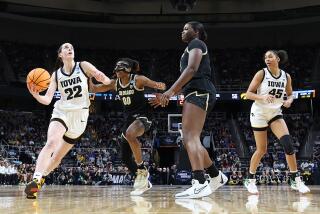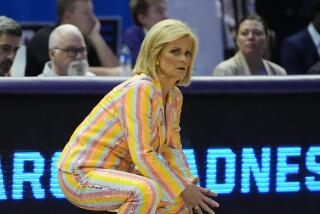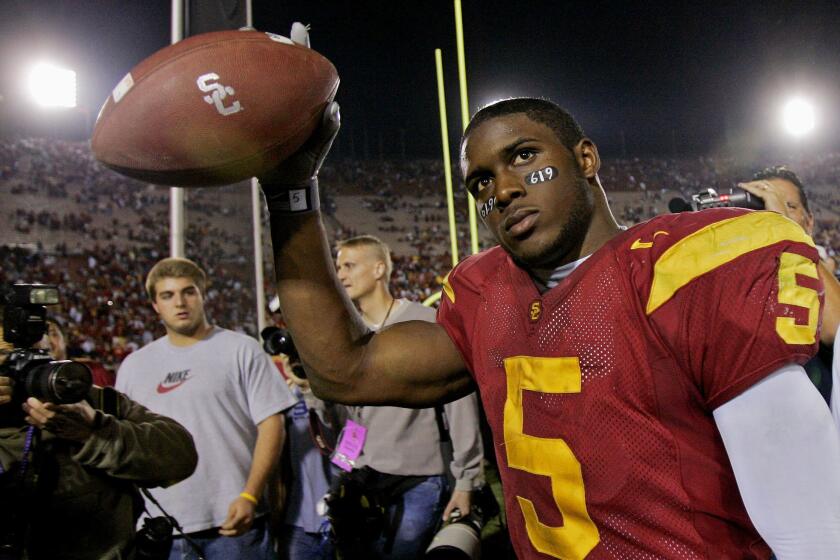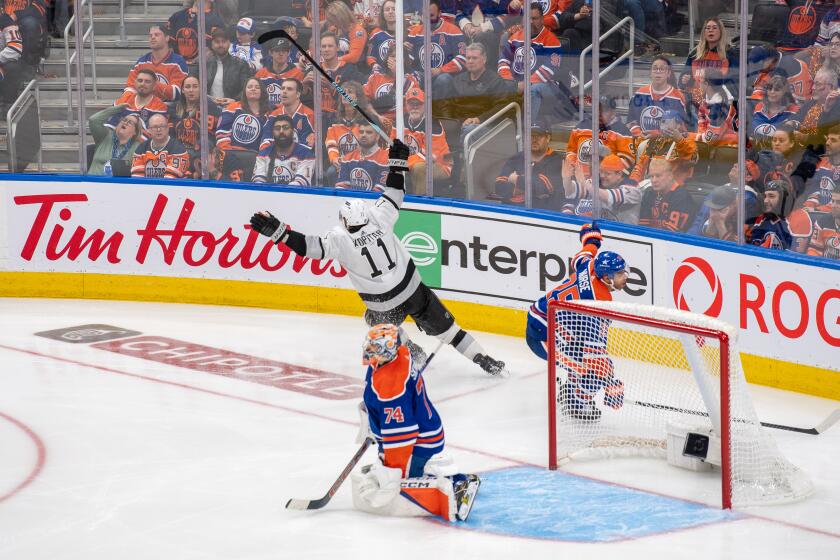Head injuries are keeping women athletes out of the game
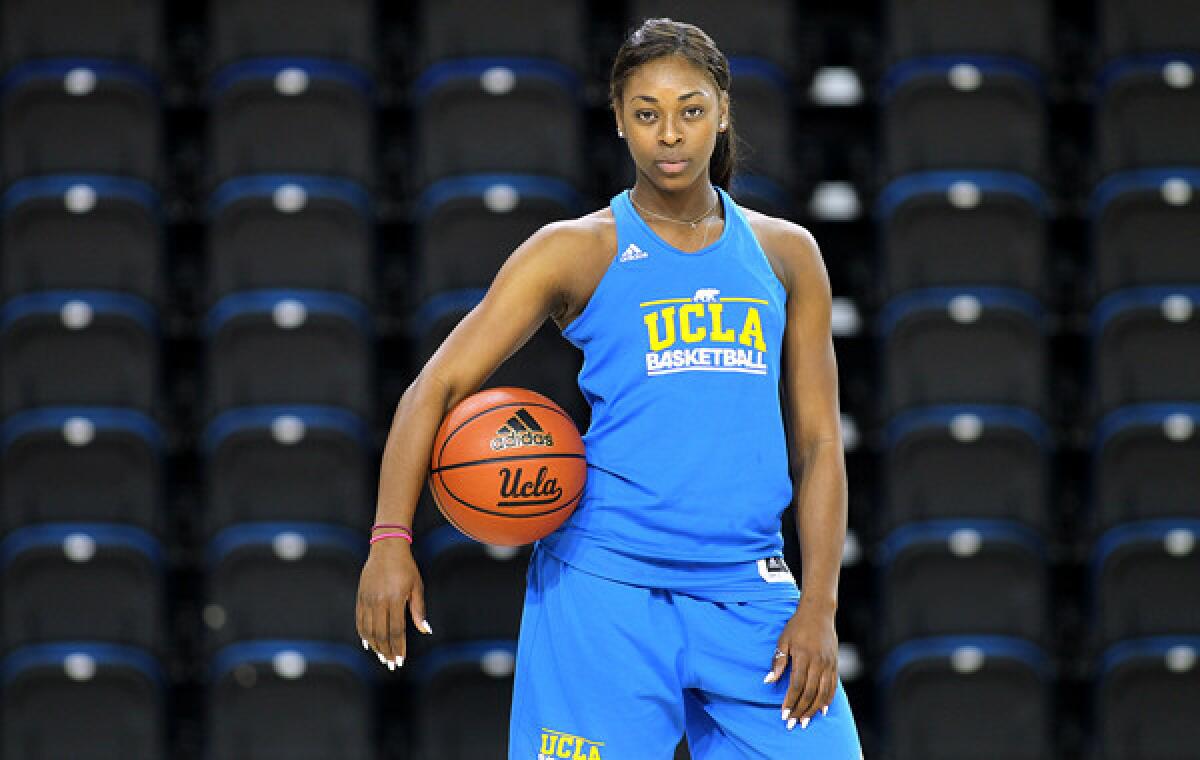
Lauren Holiday sits pensively, hands clasped in her lap, a UCLA basketball practice jersey folded around her.
Rocking slightly, she leans forward in her chair as she struggles to remember the incidents that changed her life.
She had been asked about the series of head injuries she has endured in her two seasons as a college basketball player: How many were there? When did they happen? And how?
“To be honest, I don’t really remember,” she says quietly from time to time. And then: “My memory is really bad now because of them.”
Holiday thinks she has suffered at least six head injuries. Her coach and a member of the UCLA sports information staff, sitting nearby, help fill in some of the blanks.
She sustained her two most recent concussions late last year, including a season-ending injury against crosstown rival USC in December. Knocked off balance by a screen, she was kneed in the head by an opposing player as she fell toward the floor.
Almost immediately, Holiday says, she saw a flash of red lights and knew it was bad. She had seen those lights for the first time about 13 months earlier, the result of another collision.
After that, she had persevered through a long, hard journey back to competition. Yet there she was once more, a crumpled heap on the floor.
She knew right away she was in for a setback, but didn’t realize that she once again would be sidelined indefinitely.
Holiday’s college career is an embodiment of statistics that don’t get much publicity. Sports concussions and their damaging effects have been in the news in recent years, but often the attention has been focused on football. Their impact in women’s sports hasn’t generated nearly as many headlines.
Women who play basketball and soccer at the high school and college levels are far more likely to sustain a concussion than their male counterparts, according to a 2013 study by the American Academy of Neurology. In high school basketball, they are more than five times as likely — .60 in 1,000 games compared to .11 for males. In college, the ratio is nearly two to one.
Studies have also shown that each concussion increases the risk of another, and multiple injuries increase the risk of prolonged symptoms.
Holiday, 20, is an example of that, too.
::
Holiday is a sleek-looking athlete, sinewy strong at 5 feet 8, but there is little finesse to her game. She could score some, but she was best known for hustle, grit and in-your-face defense.
She often drew the assignment of covering the opposing team’s top scorer, or maybe a point guard who was driving the Bruins batty.
No challenge was too great. Her family prepared her for that.
Holiday’s mother, Toya, was her coach at Valley Village Campbell Hall High, where younger brother Aaron is a standout point guard. Two older brothers, Justin and Jrue, are professional basketball players. Justin played at the University of Washington and now competes in Europe; Jrue played for UCLA and is now with the New Orleans Pelicans of the NBA.
Two-on-two games with her brothers left her no choice but to play tough.
“That’s her biggest strength,” UCLA Coach Cori Close says, “and also, in this case, her biggest weakness.”
Holiday suffered her first three college head injuries in the summer of 2012 during pickup games and practices before her freshman season at UCLA. In the first, she took a knee to the head as she and a male scout-team player dived for a loose ball. The second came when a scout player’s elbow struck the top of her head while they battled for a rebound. The third occurred in a similar way.
The injuries forced her to miss several weeks of practice and UCLA’s season opener as she tried to satisfy medical clearance requirements.
Each UCLA athlete is tested before the start of their career to determine his or her normal level of mental processing, memory capacity and overall cognitive functioning. If the athlete later sustains a head injury, these baseline tests are retaken and the scores compared.
“As a coach it can be frustrating because you want your player back in the game,” Close says. “But when you give me numerical data it makes it harder for me to be frustrated and gets me thinking about the well-being of my player.”
The baseline tests are just the first steps a UCLA athlete must navigate before returning to competition.
Even after initial symptoms such as headaches and nausea have subsided, the athlete is eased back into exercise with light cardiovascular work. Then come strength training and sport-specific exercises, noncontact practice and finally practice at full speed before a return to game action.
If a symptom returns anywhere along the way, the athlete must revert to the previous step. And the decision to clear a player is left to medical personnel, not coaches.
“Sometimes you have to be willing to be unpopular,” says Dr. John DiFiori, the head physician for UCLA athletics. “Our first priority is health and safety.”
Holiday made her debut in the second game of UCLA’s 2012-13 season, playing 17 minutes off the bench to help the Bruins upset No. 11 Oklahoma at Norman. She then had four points, three rebounds and a steal in 15 minutes during a loss to No. 5 Notre Dame.
In the next game, Holiday started and was assigned to guard Princeton’s leading scorer, Niveen Rasheed, a speedy and nimble ballhandler. Holiday was giving chase to Rasheed near midcourt when she ran full speed into a screen, her head connecting with the opposing player’s shoulder.
That was the first time she saw the flashes of red lights.
Her season was finished, but her battle with post-concussion symptoms was just beginning.
::
The noise generated by a loud crowd, an adrenaline rush for most athletes, makes Holiday’s head hurt.
An arena buzzer — the very sound that used to accompany her dreams of last-second, game-winning baskets — irritates her ears.
During lectures, she has trouble remaining focused. “It’s out of control sometimes,” Holiday laments.
She considered majoring in dance, but had to drop a class because the required level of physical activity was too much during her recovery.
“Sometimes I feel frustration with not being able to do things I could do before,” she says.
That frustration was evident last year, after the concussion she sustained against Princeton ended her basketball season. She felt depressed, and on the most difficult days text messages poured into the phone of her confidant, UCLA assistant coach Shannon Perry.
“I’m struggling”
“Having a bad day”
“Need a hug”
On a few occasions, Holiday just sat in Perry’s office and had a good cry.
Most times it helped. Sometimes it didn’t.
There were fits, Holiday admits, when she lashed out at people close to her. “I felt so dependent on basketball,” she recalls. “That’s who I was, a basketball player.”
She says she became convinced that people around her were conspiring with her doctors to prevent her from playing. She even stooped to lying about her symptoms, trying to convince everyone she was ready to make a comeback.
Now, she says, she realizes everyone was acting in her best interests.
She also knows she is not alone in her struggles.
::
Several high-profile female college athletes were forced to retire after sustaining multiple concussions in recent years.
Among them was Becca Wann, a standout in soccer and basketball for the University of Richmond. There were also three highly regarded soccer goalies forced to the sidelines: Emily Oliver, who won a national championship with Stanford; Molly Poletto, who played for the U.S. Youth under-17 and under-15 national teams but whose career was derailed before she ever played for the University of Utah; and Anna Cassell, another former youth national team member who starred for Northwestern.
In December, Cassell wrote an Op-Ed article for USA Today hoping to bring attention to what she calls “an epidemic of concussions in women’s soccer.”
Cassell wrote that she suffered “severe headaches, bouts of anxiety and depression, and balance problems.” She also noted, citing that American Academy of Neurology study, that women college soccer players suffered concussions more often than high school football players — 1.8 to 1.55 per 1,000 games.
Cassell’s sequence of concussions, delineated in the USA Today article, went like this: A few weeks after winning the job as Northwestern’s goalkeeper as a freshman in 2011, she was kneed in the head. The next year, she was kicked and elbowed in the head in back-to-back games, which sidelined her for weeks. She returned to finish out the 2012 season but sustained a third concussion in January 2013 while in training.
Finally, last fall, after eight months of trying to mount yet another comeback, Cassell retired after meeting with a specialist. Despite her efforts, she said she still did not feel fully in control of her body.
With her career goal of becoming a doctor at stake, she stepped away from a sport she had played since she was 4. Her reasoning: “What if . . . I get another concussion and it’s harder for me to study and then I get a bad score and don’t get into the med school I want?”
::
When Lauren Holiday agreed to be interviewed for this article, she did so on one condition: she would not be asked about her future.
As a basketball player, what’s next for her is unclear.
Her next scheduled neurological test isn’t until after the end of UCLA’s season, so the soonest she could play for the Bruins is the fall. Yet she attends every UCLA practice and game, seeking to contribute however she can.
Holiday has become something of an undergraduate coach for the Bruins, occasionally offering tips — and always encouragement — to her teammates.
She has also chosen to broaden her pursuits beyond basketball. She is interested in dancing, modeling and fashion, and even joined a campus rap club.
“I don’t rap,” she giggles, but it has allowed her to make friends outside of her normal basketball circle.
Her coaches say Holiday has grown as a leader and a person, and seems to have made peace with her situation.
Indeed, she says she wouldn’t change her experience.
“For me it’s a faith thing,” Holiday says. “I had to go through that to understand that basketball doesn’t define me. That had to happen for my coaches and the staff to learn about concussions.”
Her advice to other athletes: Don’t try to play through the pain; don’t try to return to competition before you’re really ready.
“A week is not going to kill you,” she says, “but if you can’t perform the rest of your life that’s something else.”
“Concussions are nothing to play with. You learn that from having a few and seeing a few.”
More to Read
Get our high school sports newsletter
Prep Rally is devoted to the SoCal high school sports experience, bringing you scores, stories and a behind-the-scenes look at what makes prep sports so popular.
You may occasionally receive promotional content from the Los Angeles Times.
